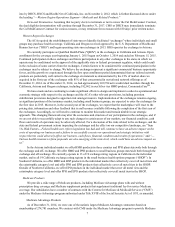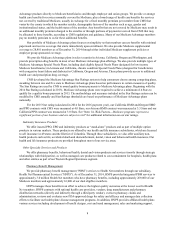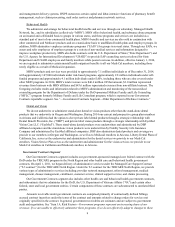Health Net 2014 Annual Report Download - page 19
Download and view the complete annual report
Please find page 19 of the 2014 Health Net annual report below. You can navigate through the pages in the report by either clicking on the pages listed below, or by using the keyword search tool below to find specific information within the annual report.17
accreditation with a score of “accredited.” Our MHN subsidiary has received a URAC accreditation status of “full” for
both Health Utilization Management and Health Network, which is the highest status awarded by URAC.
Government Regulation
Our business is subject to comprehensive federal regulation and state regulation in the jurisdictions in which we
do business. These laws and regulations govern how we conduct our businesses and result in additional requirements,
restrictions and costs to us. Certain of these laws and regulations are discussed below.
New laws and regulations, or changes in the interpretation of existing laws and regulations, including as a result
of changes in the political climate, could have an adverse effect on us. In the event we fail to comply with, or fail to
respond quickly and appropriately to changes in, applicable law and regulations, our business, results of operations,
financial condition and cash flows could be materially and adversely affected. For additional information, see “Item 1A.
Risk Factors—Our businesses are subject to laws and significant rules and regulations, which increases our cost of
doing business and could impact our financial performance by restricting our ability to conduct business or adversely
affecting our ability to grow our businesses” and “Item 1A. Risk Factors—Federal and state audits, reviews and
investigations of us and our subsidiaries could have a material adverse effect on our operations, financial condition
and cash flows.”
Health Care Reform Legislation and Implementation
The ACA transformed the U.S. health care system through a series of complex initiatives. While we have
experienced significant growth in our revenues and membership in certain products as a result of the ACA, the
measures initiated by the ACA and the associated preparation and implementation of these measures have had, and will
continue to have an adverse impact on our revenues and the costs of operating our business and could materially
adversely affect our business, cash flows, financial condition and results of operations. Due in part to the scope and
complexity of these initiatives, as well as their ongoing implementation, the ultimate impact of the ACA on us remains
difficult to predict.
• The ACA imposes significant fees, assessments and taxes on us and other health insurers, health plans and
industry participants. Among others, the ACA imposes a significant non-deductible tax (technically called
a “fee”) on health insurers, effective for calendar years beginning after December 31, 2013. In 2014, this
“health insurer fee” was assessed at a total of $8 billion nationwide. In 2015, it is expected to be assessed
at a total of $11.3 billion nationwide in 2015 and will increase annually thereafter. The health insurer fee
will be allocated pro rata amongst industry participants based on a ratio of net health insurance premiums
written for the previous calendar year to total net premiums written for the U.S. health insurance industry,
subject to certain exceptions and adjustments. In September 2014, we paid the federal government a lump
sum of $141.4 million for our portion of the health insurer fee.
• The ACA also required the establishment of state-run or federally facilitated “exchanges” where
individuals and small groups may purchase health coverage. We are participating as QHPs in the currently
operating exchanges in California and Arizona. For further information on these exchanges, see the
discussion above under the heading “—Segment Information—Western Region Operations Segment—
Western Region Exchanges.”
• The ACA also contains premium stabilization provisions designed to apportion risk amongst insurers.
These stabilization provisions include a permanent risk adjustment provision applicable to the individual
and small group markets that became effective at the beginning of 2014, which will effectively transfer
funds from health plans with relatively lower risk enrollees to plans with relatively higher risk enrollees to
help protect against the consequences of adverse selection. Other premium stabilization provisions include
the temporary reinsurance and risk corridors programs, which seek to ease the transition into the post-
ACA market by helping to stabilize rates and protect against rate uncertainty in the initial years of the
ACA. To adapt to this economic framework, we have dedicated significant resources and incurred
significant general and administrative costs to implement numerous strategic and operational initiatives
both within and outside the exchanges that, among other things, have required us to focus on and manage
different populations of potential members than we have in the past. The final determination and
settlement of amounts due or payable from these premium stabilization provisions will not occur until
2015, and there is no assurance that the strategy we have executed will be successful or that the
investments we have made to incorporate these provisions will be profitable.
• The ACA allowed extended funds to those states that opted to expand Medicaid eligibility from a pool that
included residents with incomes up to 100% of the federal poverty level (“FPL”) to an expanded pool of
























